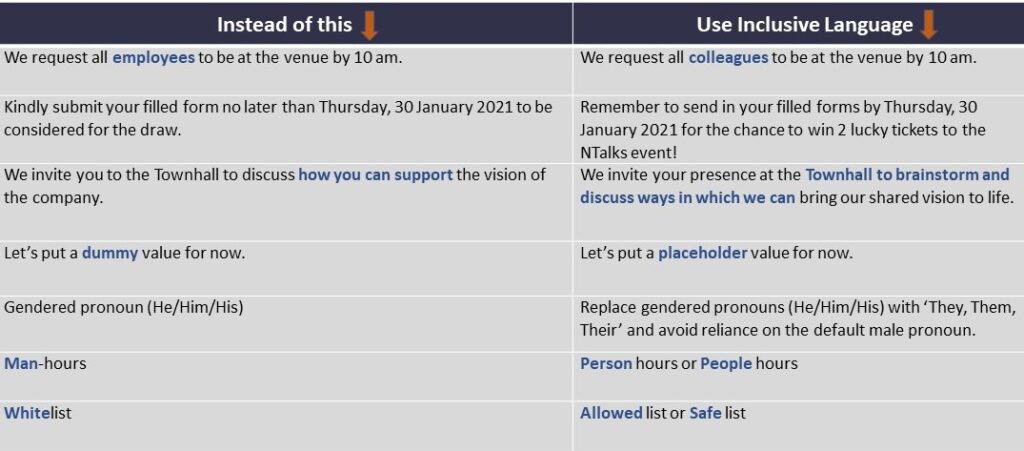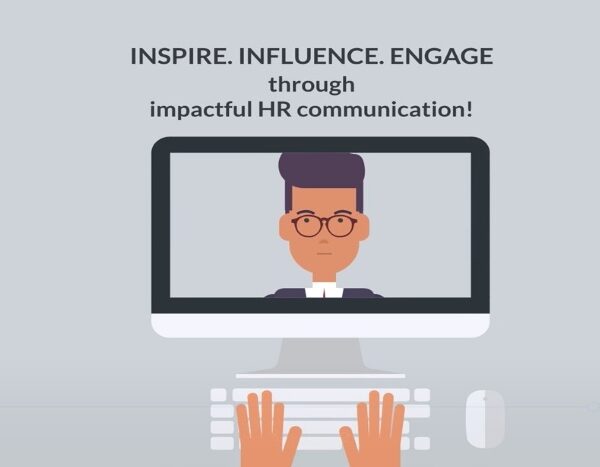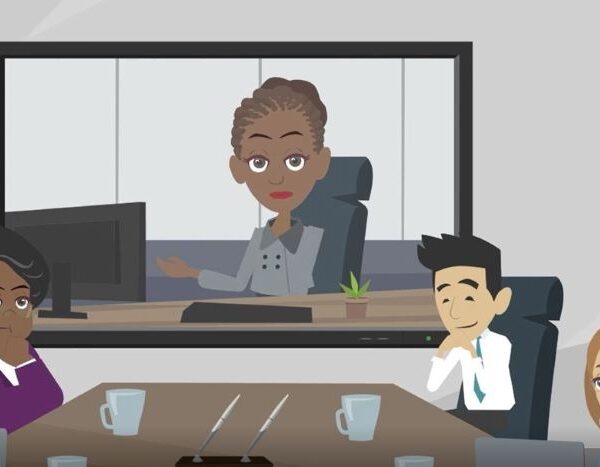#EveryoneMatters
We often hear hiring managers talk about finding candidates with a good ‘culture fit’. Alternatively, it’s worth asking ourselves what we could do as communicators to help build a company culture that places the ‘other’ in the centre of things.
Language is prolific in its potential. But whilst it helps to build relationships and forge connections, it is equally capable of building formidable walls, ‘othering’ or threatening an individual’s sense of belonging. How we talk about things or how we talk to each other influence how we treat each other as well.
Consequently, inclusive communication can help to set in motion our work place culture in decisive ways and its worth exploiting this potentiality in its arsenal to influence and nurture the sense of belongingness to the workforce so that employees feel empowered to bring their authentic self to work, to be unapologetically themselves and to give of their talents and intrinsic knowledge with undeniable commitment.
Such an approach makes employees feel valued, respected and confident to contribute to the vision.
Therefore, communicators can play an important role in helping to shape inclusiveness at the workplace by exploiting the subtleties and nuances of language to spark cultural shifts that embrace diversity and inclusion. Consequently, when employees feel that they belong, they are more likely to be engaged and motivated at work, resulting in higher levels of performance and consequentially increased customer satisfaction.
What do we mean by inclusive language?
Inclusive language avoids biases, slangs, or expressions that discriminate against groups of people based on race, gender, socioeconomic status or ability. In short, inclusive language allows you to resonate with more/diverse audience groups by speaking and writing in more impartial ways.
And what it is not.
Inclusive language is not about being politically right or not lapsing into error. Language that is overly cautious tends to be restrictive and strait-jacketed. On the other hand, the inclusive approach in communication, as in its generic sense, is about empathy, demonstrating respect, being accurate and most importantly, being relevant to everyone.
Inclusiveness when done correctly is about celebrating differences and building a culture of belonging.
5 Ways communicators can help an organisation to embrace inclusive language.
1. Language audit and fixes
Incorporate inclusive language into descriptions of processes, products and overall team communication.
Take a closer look at recruitment postings and job descriptions, community outreach materials, marketing collaterals, employee and HR communication, learning and development, performance management and managerial communication, website and social media platforms.
- Try to identify language that seeks to indicate gender bias or discriminations based on race, identity, age, ability or socio-economic status and substitute these with inclusive usage and terms.
- For example, when writing a job description, let it be a standard practice to avoid the use of gender-specific terms (man, woman etc.) that are not relevant to the position or qualifications. When presenting a generalisation, use plural noun forms (e.g., people, individuals etc.) or the plural pronoun ‘they’ rather than a masculine pronoun (e.g., he) or terms marked for masculine gender, such as ‘man’.
- When referencing individuals whose gender is not known, specified or relevant, use appropriate alternative pronouns that do not specify or presuppose a particular gender (e.g., s/he, one, or gender-neutral they).
- It is not just formal communication like job descriptions or HR processes that you should audit for inclusivity — it’s all communication, whether through email, text, social media, or in-person.
Language has a strong impact on one’s sense of belonging in the workplace and at the same time it is highly nuanced. So, when it comes to implementing inclusive language, it takes consistent practice to shift typical ways of speaking and writing in ways that are small or of heavy impact.
Even an email requesting change in meeting schedule or an invite for registration can be made ‘more’ inclusive and respectful with a little thought, effort and time as in examples below.
Sentence 1: “Can’t make it. Please shift to tomorrow.” (Authoritative and direct)
E.g., of Inclusiveness: “Sorry, can’t make it today. Possible to catch up tomorrow, same time?” (shows consideration and respect)
Similarly, Sentence 2 below is authoritative, directional and totally acceptable. However, if required, you can level up the inclusivity by moving away from hierarchy and being more welcoming.
Sentence 2: “Please submit your filled requests before 29 Jan, 5 pm, to be considered for the NTalks event entry.”
E.g., of Inclusiveness: “Please remember to send in your filled event entry requests by 29 Jan, 5 pm. We look forward to the opportunity to welcome you at NTalks, for an evening of inspiring conversation and networking.”
2. Create an inclusive language toolkit
Create a toolkit or a framework for inclusive language to encourage and enable employees to use language that affirms and is inclusive and respectful.
Share the same with department heads and communicators in individual departments. If possible, create a short video that explains the use of toolkit and conduct user trainings across the enterprise. Similar to the persistent way in which communicators/ marketers ensure brand guidelines are adhered to by internal stakeholders, encouraging colleagues to use inclusive language is also a persistent process that calls for periodic reminders. Make managers and department touch points your ally and through them, over the course of time, you can affect a shift to inclusive language.
Examples of inclusive language

Overall, be mindful of the below when you communicate.
- Check that you are being thankful, affirmative, grateful for efforts when you communicate.
- Be flexible and open to suggestions and try to view the communication situation from multiple perspectives to allow changes to the communication.
- Use gender neutral/ gender inclusive language.
- Lastly, take care to use universal phrases that is known to your target audience and does not alienate a group from joining in the conversation due to lack of cultural connect with phrases or expressions that you use.
3. Targeted communication as per audiences
Analyse different target groups and shape communication that is ‘relevant’ to them.
Identify different stakeholder groups across the organisation and deep dive into how their communication needs differ. Also identify the impact and positive outcomes of various types of communication on each of these groups.
- What do they need to perform their responsibilities better?
- What would make them feel engaged/ disengaged?
- What would help them to ace their responsibilities?
Consider the above with respect to each stakeholder group when issuing any communication. Conducting this exercise is more relevant if your audience is dispersed across geographic boundaries or if the audience requirements differ widely due to nature of their job.
This not only helps to ensure the relevancy of messages but also to shape the communication (strategy and execution) to encompass the needs of every target audience group across the organisation, moving one step closer to inclusivity through the power of words.
4. Internal news channels and engagement platforms
While pitching story topics for internal communication channels, include not only the big launches and initiatives, but also the significant moments where colleagues lived the corporate values.
Proactively create platforms, opportunities, events/initiatives that enable acknowledgement and appreciation of efforts at all levels, of different measures of organisational impact.
Ensure that marketing collaterals, customer communication, social media content, corporate image libraries and content produced for internal and external consumption give adequate representation to all sections of the workforce.
5. Strategic alignment from within
As communicators, let’s be the trail blazers role modelling inclusiveness. Weave the concept of inclusion when you present your annual communication plan, together with its importance and how it will be implemented across various campaigns. By making it visible and pinning it down, it provides another opportunity for leaders, managers and employees to demonstrate inclusiveness in their daily operations, acts and decisions.
Why is this important?
An important part of building a great organisation is to make everyone feel welcome, respected, safe and instil a sense of belonging. The way an organisation communicates helps to shape the way in which it is perceived by current and prospective employees alike.
In other words, the language a company uses reflects:
- Its intent
- How conscious or unconscious it is regarding diversity issues
- The degree to which everyone is seen, heard and valued
- Whether everyone has a future in the organisation
- How much effort is being made to ensure employee success
- How accountable the organisation is willing to hold itself and its employees for implementation and infringements .
(Qtd from Deborah L Johnson, Cultural Diversity trainer)
By shaping an inclusive work environment, you are in fact enabling equitable access to opportunities to everyone.
Inclusive business environments enhance productivity, performance, engagement, innovation and well-being. This happens simply because people believe they matter, that they are seen, that they belong.
Significantly, it helps to attract the right talent. Surveys show how an increasing majority prefer a company that is diverse, inclusive and makes them feel included regardless of race, ethnicity, geographical location, disability, socio-economic status and appearance.
Perception as well as reality can often be created, maintained and altered by communication. Language is powerful and communicators have the unique privilege to harness the power of words to set expectations, unite and drive action around diversity, equity and inclusion at the organisation.
Want to outsource your internal communications?
For internal communication outsourcing and support, please reach out to:
Email: info@commsimpact.ae / WhatsApp: 052 530 8771





